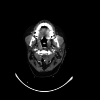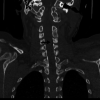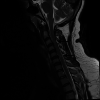Pneumorrhachis Following Neck Penetrating Injury: A Case Report
- PMID: 36580083
- PMCID: PMC9793097
- DOI: 10.7759/cureus.31925
Pneumorrhachis Following Neck Penetrating Injury: A Case Report
Abstract
The development of air in the spinal canal is an uncommon and usually asymptomatic event. Also known as pneumorrhachis (PNR), the main information about this phenomenon is based on a few case reports published previously. It is highly difficult to identify this entity clinically, and in most publications, PNR was incidentally identified during image procedures, mainly computed tomography (CT) scans. With the advancement of technology and the development of guidelines for the treatment of penetrating and neck injuries, the number of PNR diagnosis has increased. It is also a common agreement among the articles reviewed that the least common cause of PNR is traumatic events. This report presents a rare case of pneumorrhachis as a consequence of a penetrating neck injury. The studied patient was a 27-year-old female with multiple stab wounds on the left posterior side of the neck and left shoulder, thereby developing left-side body weakness as a consequence of the wound. The patient was immediately evaluated and managed by the emergency team, and as the patient was vitally stable, she was shifted to an urgent CT scan. CT scan showed subarachnoid air focus, multiple extradural air foci, and spinal cord injury on the cervical spine. This patient was treated conservatively, but her neurological symptoms persisted until discharge.
Keywords: free air on spinal canal; head and neck trauma; neck; penetrating neck injury; pneumocele; pneumorrhachis.
Copyright © 2022, Tannouri et al.
Conflict of interest statement
The authors have declared that no competing interests exist.
Figures
Similar articles
-
Traumatic pneumorrhachis: 2 cases and review of the literature.Am J Emerg Med. 2015 Jun;33(6):861.e1-3. doi: 10.1016/j.ajem.2014.12.040. Epub 2014 Dec 26. Am J Emerg Med. 2015. PMID: 25595271 Review.
-
Symptomatic epidural pneumorrhachis associated with an occult pneumomediastinum due to minor trauma.Spine (Phila Pa 1976). 2009 Dec 15;34(26):E979-82. doi: 10.1097/BRS.0b013e3181b03ecb. Spine (Phila Pa 1976). 2009. PMID: 20010389 Review.
-
Pediatric Traumatic Pneumorrhachis: Case Report.Pediatr Neurosurg. 2019;54(2):143-146. doi: 10.1159/000496395. Epub 2019 Feb 7. Pediatr Neurosurg. 2019. PMID: 30731460
-
Pneumorrhachis and hyponatremia after a neck hack-A case report.Int J Surg Case Rep. 2020;68:174-177. doi: 10.1016/j.ijscr.2020.02.063. Epub 2020 Mar 3. Int J Surg Case Rep. 2020. PMID: 32172192 Free PMC article.
-
Narrative review of traumatic pneumorrhachis.World J Crit Care Med. 2023 Dec 9;12(5):248-253. doi: 10.5492/wjccm.v12.i5.248. eCollection 2023 Dec 9. World J Crit Care Med. 2023. PMID: 38188452 Free PMC article. Review.
References
-
- Traumatic pneumorrhachis: systematic review and an illustrative case. Osunronbi T, Sofela A, Sharma H, Muquit S. Neurosurg Rev. 2021;44:731–739. - PubMed
-
- Traumatic pneumorrhachis in a child: case report. Kaya U, Akay H, Arslan ED, Günaydn M, Büyükcam F, Tez M. Pediatr Emerg Care. 2010;26:852–853. - PubMed
-
- Traumatic pneumorrhachis. Goh BK, Yeo AW. J Trauma. 2005;58:875–879. - PubMed
-
- Traumatic pneumorrhachis: 2 cases and review of the literature. Kara H, Akinci M, Degirmenci S, Bayir A, Ak A. Am J Emerg Med. 2015;33:861–863. - PubMed
Publication types
LinkOut - more resources
Full Text Sources



